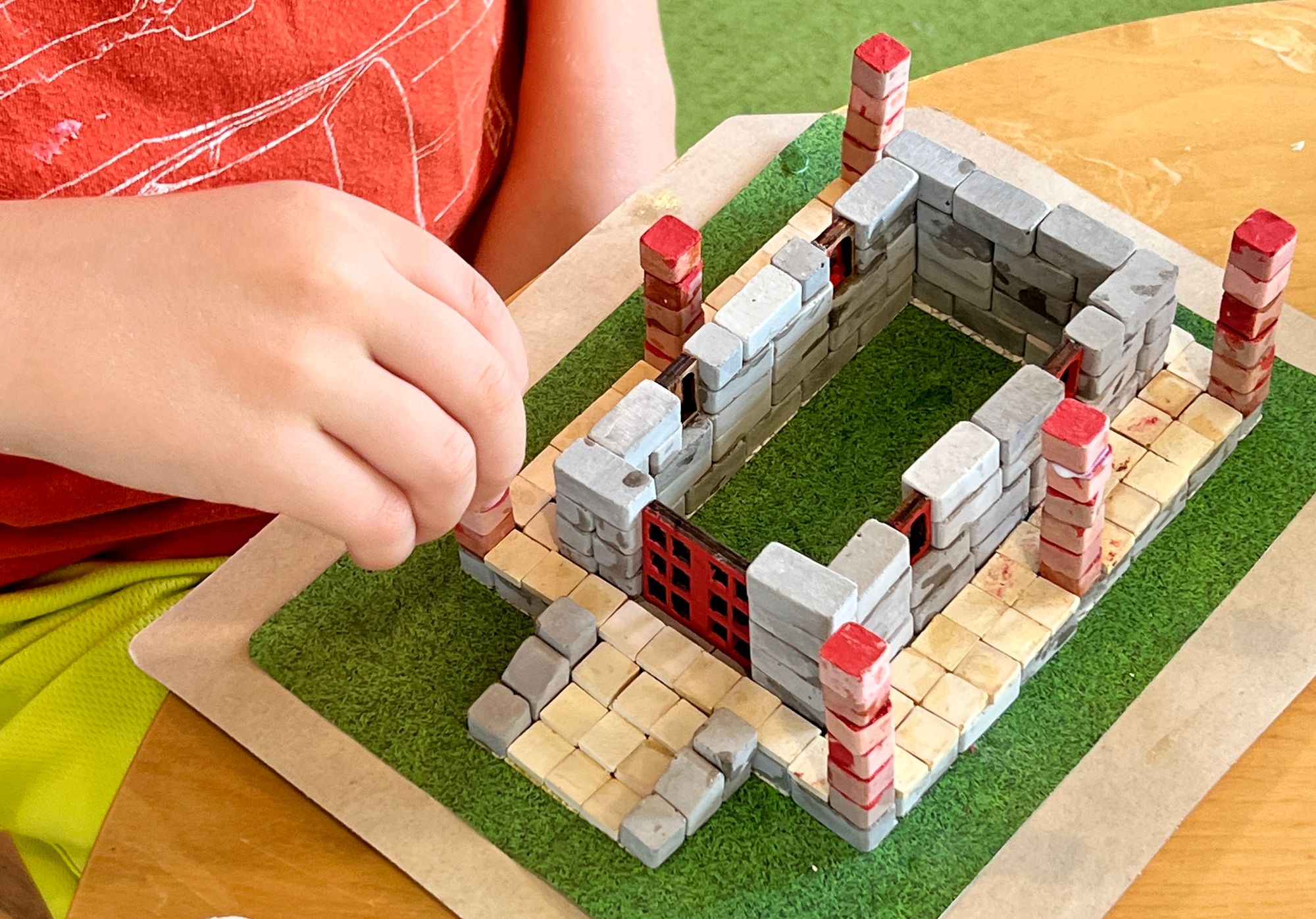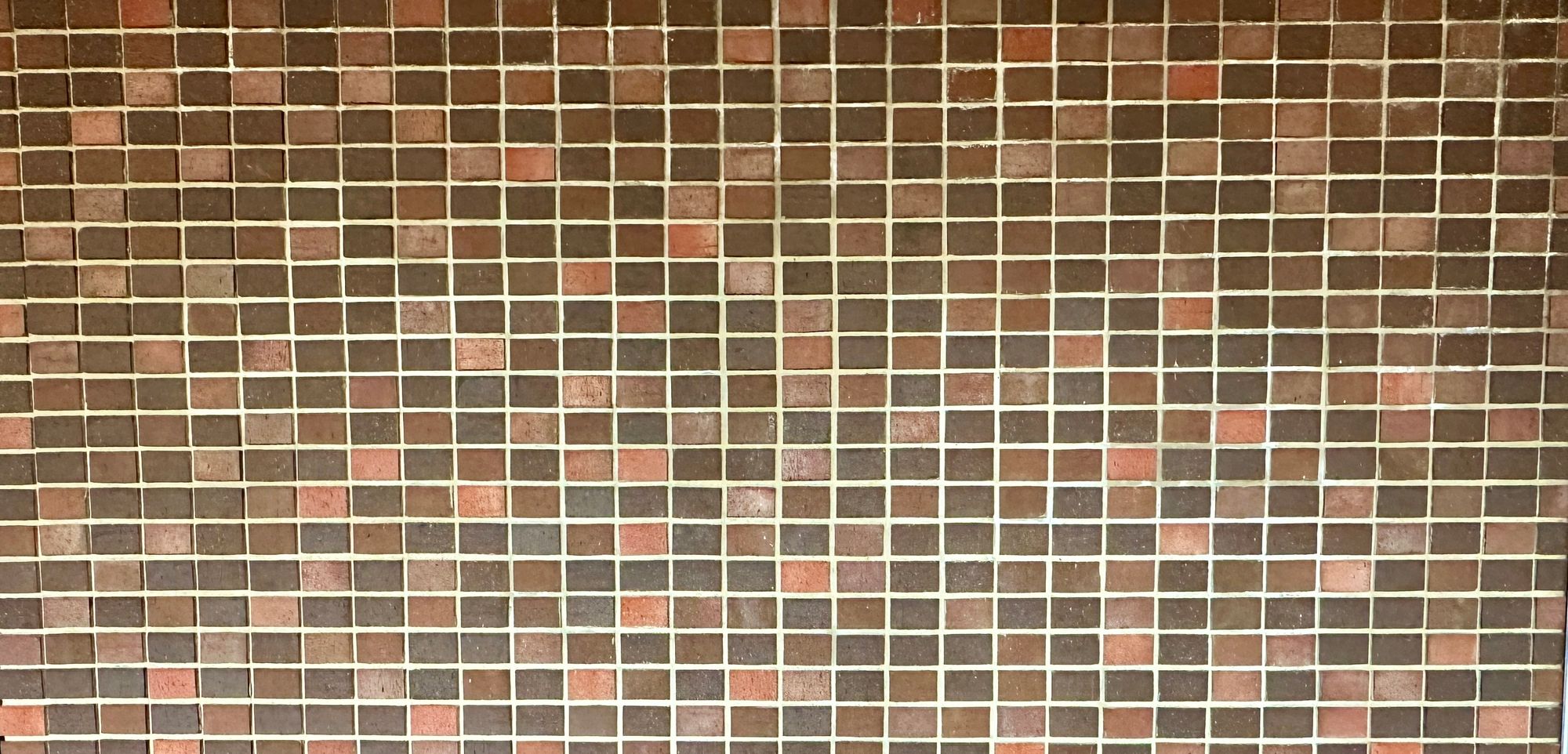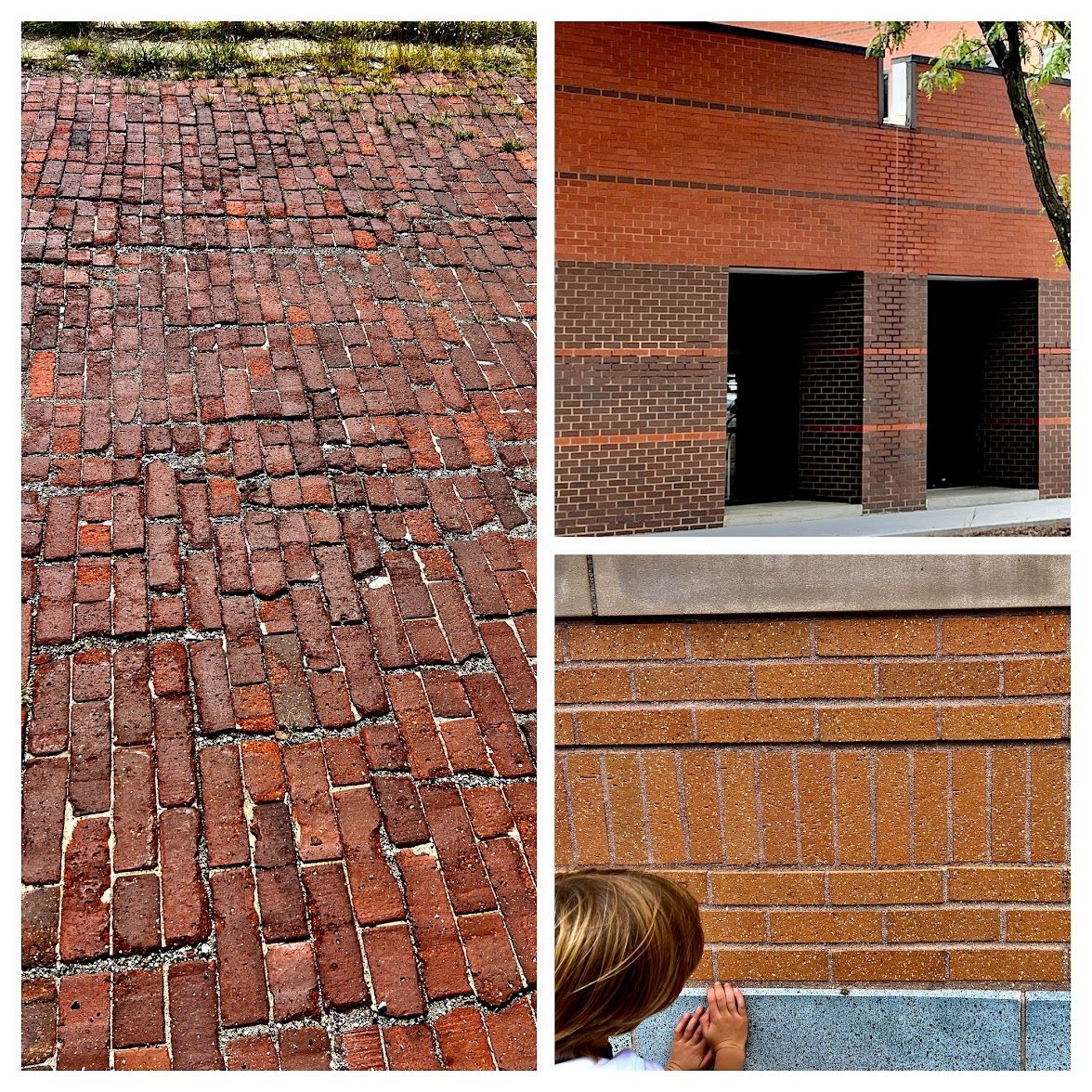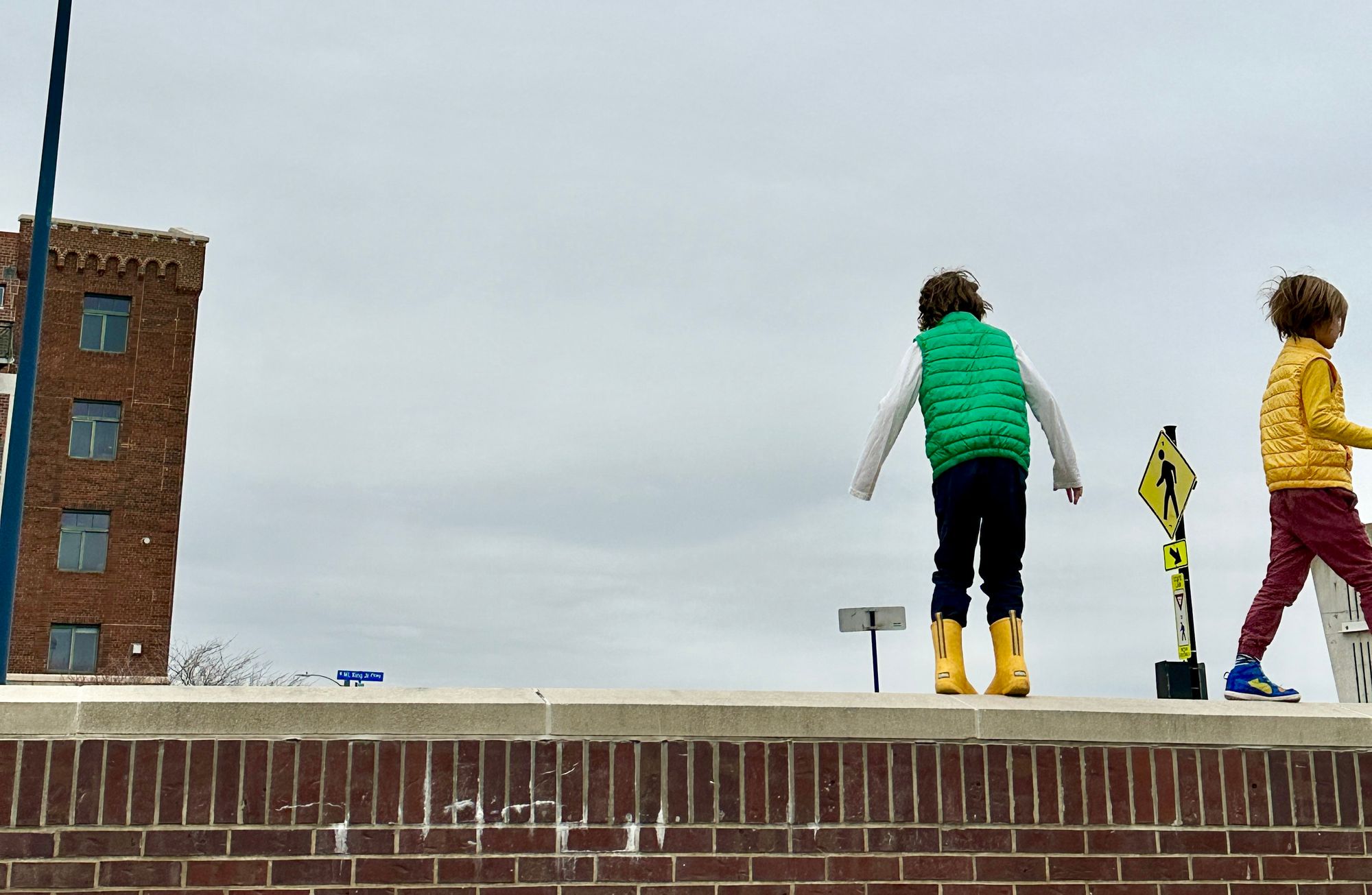Bricks: Our Frobelian Project-Based Lesson

Our ongoing homeschool project for the 2022 school year started when Arthur (7) decided to begin building his new Wise Elk construction set, Chinese House. Once he started building, he wanted to do almost nothing else. He had to stop periodically to let the glue dry before building further, and his excitement to keep building and watching it progress sustained his interest.

Fred (5) also started building his Wise Elk set, the Windmill.
As his structure grew, the cylindrical shape of the windmill reminded us of a book we'd recently gotten from the library called On the Other Side of the Forest. The book is about a boy (well, a rabbit boy) who helps his dad build a stone tower to see what is on the other side of the forest.
We considered the building technique used by the characters in the book (mostly piling stones). We compared it to how Fred built his windmill: very carefully and methodically.
When asked, "How else could you build a tower?" the boys got out the Froebel divided cylinder gift to show me how they could build towers from that, too.

To turn this child-led activity into a Froebelian homeschool project, I had to think broadly. These small bricks are made of gypsum (in Ukraine!); what is gypsum, and where is it found? Then, linking it to our lives: What are architectural bricks made from? Where is it sourced? How are they made? How are they used? Ultimately it morphed into a four-week project and became an ongoing interest of ours.
We started by checking out books from the library to learn more. Our favorite was Billions of Bricks. The illustrations are very detailed, and we enjoyed seeing the clever ways the bricks were used and the different patterns. There were illustrations of people making bricks and of masons in action.
Another informative book we checked out was: Brick, A World History. It is a dense book that covers everything from ancient Rome, Egypt, and China. We enjoyed reading about the earliest uses of brick and seeing all the different ways the material has been used throughout human history. We even read a little about Chinese architecture and found buildings with similar elements to A's Wise Elk Chinese House.

Encouraging a connectedness to one's family and community is central to Froebel's teaching philosophy.
To connect the project to our family, I asked the boys about their experiences with brick.
They pointed out that the outside of our house is mostly brick, and some of our walls inside are as well, and that they like to drive their cars along it like a road. They brought to my attention an element of the brick that they thought was a little odd: Some of the brick walls inside look like they extend right through the windows to the brick exterior walls. We looked at some architecture books, and they saw that this is a fairly common feature of midcentury architecture, bringing the outside in.
They recalled when our new garage was under construction: We watched the masons laying the brick as well as we could, but they put up tarps because it was supposed to get cold, so we couldn't see very much.
We looked at our house and the random colors of brick. We tried to count how many different colors there are. Some seemed to change with the sun, so there was a lot of debate! We talked about how, when the garage was finished, we learned that randomness takes a lot of skill. However, if it doesn't look random when they're done (sometimes, if the mason isn't trained in this style, inadvertent patterns arise), they can apply a colored clay slip (like watery clay paint) to change the appearance of the pattern.

Walking around inside our house, we noticed that there are three different patterns the brick are laid in: stretcher bond (the most common pattern), stack bond (all lined up, lengthwise), and header stacked bond (all lined up, brick turned to see the narrow end). It was fun figuring out the names of the patterns.

Encouraging a connectedness to family and community is central to Froebel's teaching philosophy
Encouraging a connectedness to one's family and community is central to Froebel's teaching philosophy.
So, after connecting the lesson to our family and home, we decided to search for brick in our community. We came up with the idea to have a "brick walk" where we explored the streets around the city to see what we could find.

We drove and walked around town one morning exploring. It was Memorial Day, and there was very little traffic downtown. Not many people were out on the streets, so it felt like we had the buildings and neighborhoods to ourselves.
Walking around, we found many uses of brick: entire buildings, decorative columns, garden walls, walkways, and even a few roads made of brick. We noticed different layouts and patterns. We also noticed many variations in the color and texture of the clay, and we compared old brick and new.

We brought along Froebel gift 4 (the elongated rectangular blocks) to recreate patterns we saw and to build with them.

One of the places we visited on our "brick walk" was a historic train station we'd found when we learned about trains last year. During this visit, we noticed the different brick colors and the old station's architectural features. We even found a really old brick road across the street.
The kids had the most fun running along what remains of the old train track with grasses and wildflowers growing around it.

Overall, the brick walk turned out to be a lot of fun! We were surprised by how many brick buildings we saw and how different they were – and how many different ways brick was used. We noticed far more colors, textures, and patterns than we had imagined.

Follow-up activities in these project-based lessons are intended to revisit and build upon previous learning. We discuss the ideas or materials in a new way, and a new element may be introduced to aid in learning and internalizing the experience. One of the ways we did this was by looking at photos from our walk and recreating some of the things we saw. Froebel would call these Forms of Life. The boys used the colorful Froebel line gifts to simplify the shapes and forms we saw by recreating them with a line.

To delve deeper into the lesson, we became curious about how bricks are made. I searched for a local or regional brick manufacturer. I knew there used to be several in Iowa, but when I tried to find one to visit, I found they'd all closed.
To tie in history, we researched when and why this happened. We looked at some old photos of the now-closed Iowa brickyards and talked about how all of the companies started small and subsequent trajectories. We learned that by 1890 Sioux City, Iowa (a few hours from where we live) was the largest producer of bricks west of Chicago. In 1913, Sioux City Brick acquired all the other brick manufacturers in the area. Then, in 2019, it was acquired by an Australian company expanding an earlier acquisition, the largest brick manufacturer on the East Coast. I later learned there is still a brickyard in Sioux City, however, I was informed they do not give tours.
I recalled an episode of This Old House on PBS from years ago where the mason goes to a brick manufacturer on the East Coast and is shown how they're made. When we watched the episode, the kids were surprised by the large-scale operation – the enormous kilns, the vast drying and cooling buildings, and the extreme heat needed to make the brick. They were also surprised by how much moisture is removed from the clay during the drying process - and how much the brick shrinks during the whole process. We also watched a clip of Mark the mason teaching a homeowner how to lay brick.
Wanting to go see more brick, we visited one of our favorite parks where historic brick is used a decorative element on a city building.

Bricks from all over the US were there! We didn't remember really looking at them much before and were impressed by the uniqueness of them all. We'd never seen so many different colors of clay, and some of the bricks had relatively intricate patterns, and the names of where the bricks were made is imprinted on each brick. It was interesting to see how the color of the clay varies so much from place to place. We made rubbings to document our favorite brick designs.
Inevitably, we looked for fossils in the landscaping rock because we always find something. Fossils are quite common in limestone, and limestone is very prevalent in Iowa. (So, as we found out, is clay and – gypsum!) Limestone has been quarried over the last century for construction, so there is a lot of crushed limestone in the local landscaping rock, and we enjoy searching through it for fossils. This brought us to a conversation about how minerals (and clay) are mined or harvested.

Similarly, on a recent trip to the Florida Keys, we were awestruck to find the gravel and landscaping rock is all coral! We noticed many building components (large blocks, columns, walls, walkways) were made from fossilized coral, the way that limestone is used in construction in Iowa. This brought us back to our rock and fossil project from last year when we learned that Iowa and most of the US was a seabed during the Devonian Period - and that Iowa is built on seashells (what limestone is made of) and Florida is built upon fossilized coral.

A central concept in Froebel's education system is beginning with a "whole," then breaking it down into parts, and ultimately putting it back together again.
This concept illustrates the relationship of the individual to their wider community. As individuals, we are all whole, yet we are made up of parts: our family, different communities, and the world. As such, Froebel wrote about his belief in the importance of maintaining connectedness to our families, communities, and our world. Froebel designed his gifts 3-6 on this concept: Each gift is carefully opened while respecting the whole, taken apart, the parts are appreciated and used to create something or many things, and then it is all built back into a whole.
Start with a whole, break it into parts, then put it back together again.
With this in mind, we broke down the idea of bricks even further. We needed to find some natural clay. We looked for clay deposits in our yard and in a creek bed where we'd found clay, but this time we found little. Our second idea was to work with Mexican red clay (and working with clay is a Froebel occupation!). We made individual miniature bricks with the clay and let them dry in the sun.
My older son pointed out that, had we used a mold to make them, our bricks would have been easier to build with because they'd all be the same size and shape!

Even so, we used our own awkwardly shaped mini bricks to build simple structures and walls and thus brought our project back to a "whole" once again.

Thanks for checking out what we're up to! Come back soon for a reading of our current favorite picture book, On the Other Side of the Forest, read by Arthur. We love the unexpected teamwork, the emphasis on being part of a community, and helping each other through adversity. A very responsible and reliable kid is at the heart of the story, and it has a fun ending. Lovely illustrations too!

